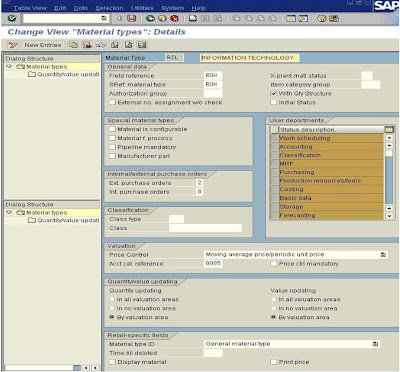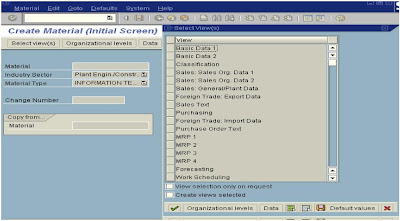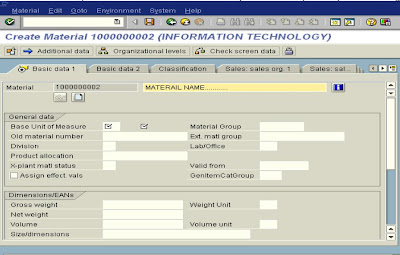• Different types of Master Data in SAP MM are: -
1. Material Master
2. Vendor Master
3. Info Records
4. Source list
5. Quota Arrangement
Material: - The goods that are subject of business activities. The material can be traded, used in manufacture, consumed, or produced
Material Master: -
It is a Master file which contains information of a particular material, depending upon the views selected from the user departments.
• Different types of views available in Material Master Record are
1. Basic data 1 & 2
2. Purchasing
3. General plant data storage 1 & 2
4. Warehouse Management 1 & 2
5. MRP (Material required planning) 1,2,3,4
6. Accounting 1 & 2
7. Costing 1 & 2
8. Quality Management
9. Plant Stock
10. Storage Location Stock
11. Classification
12. Forecasting
13. Purchase Order Text
14. Foreign Trade: Import Data
Material Type: -
It is a key that assigns the material to a group of materials such as Raw materials, trading goods. This allows you to manage different materials in a uniform manner in accordance with your company's requirements.
The Material type defines certain attributes of the material and has important control functions.
UseWhen creating a material master record, the material type determines
• Whether the material number is assigned internally or externally
• From which number range interval the material number comes
• Which screens are displayed
• The order in which screens are displayed
• Which department-specific data is displayed for the user to enter
Different Material Types available: -ROH - Raw Material
FERT - Finished Product
HALB- Semi finished Product
HAWA- Trading goods
DIEN - Services
ERSA - Spare Parts
PIPE - Pipeline material
LEIH - Returnable Packaging
HERS- Manufacturer Parts
FGTR - Drinks
FOOD- Foods
FRIP - Perishable Goods
Configurable materials (KMAT): Configurable materials are materials that can have different variants. For example, an automobile can have different types of paintwork, trim, and engine.
Finished products (FERT): Finished products are produced in-house. Since they cannot be ordered by Purchasing, a material master record of this material type does not contain purchasing data
Non-stock materials (NLAG): Non-stock materials are not held in stock because they are consumed immediately.
Non-valuated materials (UNBW): Non-valuated materials are managed on a quantity basis, but not by value.
Packaging materials (VERP): Packaging materials are used to transport goods and come with the goods free of charge. A material master record of this material type is managed on both a quantity basis and value basis.
Pipeline materials (PIPE): Materials such as oil, power, or water that flow into the production process directly from a pipeline, line, or other type of conduit. Since pipeline materials are always available, they are not planned.
Raw materials (ROH): Raw materials are always procured externally and then processed. A material master record of this type contains purchasing data, but not sales data since they cannot be sold.
Semi finished products (HALB): Semi finished products can be procured externally and manufactured in-house. The company then processes them. A material master record of this material type can contain both purchasing and work scheduling data.
Services (DIEN): Services can be performed internally or procured externally (outsourced). They cannot be stored or transported.
Spare parts (ERSA): Spare parts are used to replace defective parts. They may be kept in stock. A material master record of this material type can contain purchasing data, but not sales data.
Trading goods (HAWA): Trading goods are always procured externally and then sold. A material master record of this material type can contain purchasing data and sales data.
Material Group: -T Code WG21Key that you use to group together several materials or services with the same attributes, and to assign them to a particular material group.
SPRO �� IMG �� Logistic General �� Material Group �� Create Material Group
Price Control: - Two types of Price Controlled given by SAP
1. Moving Price – ‘V’
2. Standard Price- ‘S’
Standard Price:1. Valuation using a standard price has the following features:
2.All inventory postings are carried out at the standard price.
3. Variances are posted to price difference accounts
4. Variances are updated
5. Price changes can be monitored
If a material is assigned a standard price (S), the value of the material is always calculated at this price. If goods movements or invoice receipts contain a price that differs from the standard price, the differences are posted to a price difference account. The variance is not taken into account in valuation.
Moving Average Price:Valuation using a moving average price results in the following:
• Goods receipts are posted at the goods receipt value.
• The price in the material master is adjusted to the delivered price.
• Price differences occur only in exceptional circumstances.
If a material is assigned a moving average price (MAP), the price is automatically adjusted in the material master record when price variances occur. If goods movements or invoice receipts are posted using a price that differs from the moving average price, the differences are posted to the stock account; as a result, the moving average price and the value of the stock change
Valuation Class: - (For creation T Code OMSK)It is used to determine which stock account is updated during the goods movement of a material. It is maintained inAccounting 1 view in material master record.
For material type ROH take valuation class as 3000, 3001, 3002, 3003
For material type HAWA take valuation class as 3100, 3010
For material type FERT take valuation class as 7920.
For material type HALB take valuation class as 7900. 7910
For material type DIEN take valuation class as 3200
For material type ERSA take valuation class as 3040
Number Ranges: -Number ranges are maintained for each & every document, Posted in the SAP System. The maximum numbers of digit allowed are 18digits (99, 9999, 9999, 9999, and 9999).
Two types of number ranges: -
Internal number ranges - System will automatically define numbers to all documents
External number ranges - User has to give doc number externally while creating document.
Customize settings for creating Material Types: -SPRO�� SAPIMG �� Logistics General ��Material Master �� Basic Settings �� Material Type
• Define Attributes of Material Type
• Define Number Ranges for Each Material Type
• Define Attributes of Material Type
Select the material type e.g. ROH �� click on copy button

Change the Material Type from ROH to say RIL (Information technology)
Keep External Number Assignment without check


Press Enter �� Save
{Account Category Reference: - It is group of valuation classes
Item Category Group: - Group of material that the system uses to determine item category for the processing of sales document.}
Again select the material type & click on Quantity / value updating (left side)

Select the valuation area or Plant along with newly created Material type.
Activate / select Quantity updating or Value updating.
Valuation area: - Organization level at which material valuation is carried out

Then Save.
• Define Number Ranges for each Material Type
Click on Groups (Maintain) – F6
Click on Groups (Menu bar) �� Insert
Write some text
Give number from _____ to ______.
Select the Material Types newly created.
Click on select element (F2)
Select the group & click on Element / Group
Save.
To Create a Material MasterTransaction code: -
MM01: To create & to extend the material
MM02 :To change / edit
MM03 :To display
MM06 :To deletes the Material master
MM50 :To extend the Material views
MM60 :To See Material Master List
MMAM : To Change the Material Type
• Path of - MM01SAP Easy Access �� Logistics �� MM �� Material Master �� Material �� Create General
• To Create Material Master: - Transaction Code: - MM01

Select Industry Sector & Material Type �� Press Enter
When you create a material master record, you are required to classify the material according to industry sector and material type.
Industry SectorKey that specifies the branch of industry to which the material is assigned
Use: When you create a material master record, the industry sector determines
• Which screens appear and in what order
• Which industry-specific fields appear on the individual screens
Then Click on Organization levels select Views & Press Enter

Enter Plant & Storage Location then Press Enter
Enter all the required fields in different Views (Basic data1, Sales, Accounting etc)

After entering all the fields Press enter and Save
Fields in different views in Material Master• Basic Data 1Material Description
Basic Unit of Measure
Material Group
Old Material Number
X- Plant Material Status- Blocking option
General item category
Gross Weight
Net Weight
Volume etc
• Basic Data 2 – contains Design Drawing information
• PurchasingBasic unit of measure
Purchasing Group
Material Group
Plant – Specific – Material Status - Blocking option
Source list
Batch Management – Automatic PO
Purchasing value key
GR Processing time (number of days required after receiving a material for inspection & then placed into the storage location)
Critical Part
Manufacturer Part number
Manufacturer
• General Plant Data Storage 1: -Basic Unit of measure
Temperature conditions
Storage Conditions
Container Requirements
Hazards material number
Batch Management
SLED (Shelf Life Expiration Date)
• General Plant Data Storage 2: -
Plant
Gross weight
Net Weight
Negative stock in plant
Profit Center
• Accounting 1: -Basic Unit of Measure
Valuation Class
Price control
Price unit
Valuation Category
Currency
Moving & Standard Price
Total Stock
Total Value
Division
• Accounting 2
Tax Price 1,2,3
Commercial Price 1,2,3
LIFO Pool
• Work SchedulingUnit of issue
Production unit
Plant specific material status
Tolerance data
Material group
Batch management
Base quantity
• Quality management
Unit of issue
GR processing time
Plant specific material status
QM Control key
QM procurement active
No comments:
Post a Comment
Note: only a member of this blog may post a comment.